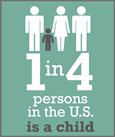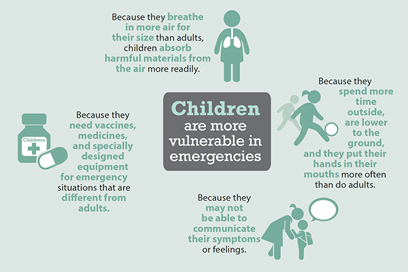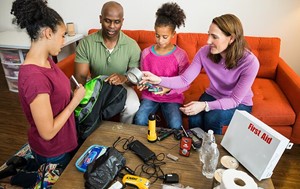It’s Children and Youth Emergency Preparedness Month
The Centers for Disease Control and Prevention (CDC) recognizes August as “Children and Youth Preparedness Month” because children are more vulnerable than adults in emergency situations, such as a natural disaster or disease outbreak, which can happen anywhere and at any time.

NYCHA’s Environmental Health and Safety Department (EHS) would like to share the following information from the CDC on protecting children in an emergency.
Children are more vulnerable in emergencies
Children’s bodies are different from adults’ bodies:
- They breathe in more air per pound of body weight than adults.
- They have thinner skin, and more of it per pound of body weight.
- They have less fluid in their bodies, so fluid loss (e.g., dehydration, blood loss) can have a bigger effect.
- They are more likely to lose too much body heat.
Children need help from adults in an emergency:
- They don’t fully understand how to keep themselves safe. Young children may freeze, cry, or scream.
- They may not be able to explain what hurts or bothers them.
- They are more likely to get the care they need when they have parents or other caregivers around.
Mental stress from a disaster can be harder on children:
- They feel less of a sense of control.
- They understand less about the situation.
- They have fewer experiences bouncing back from hard situations.

How to help children in an emergency
Children react, in part, to what they see from the adults around them. When parents and caregivers deal with a disaster calmly and confidently, they can provide the best support for their children. Parents can be more reassuring to others around them, especially children, if they are better prepared.
Before an emergency
- Talk to your children so that they know you are prepared to keep them safe.
- Have an evacuation plan.
- Prepare a “go bag” for emergencies that includes:
- First aid kit
- Flashlight
- Battery-powered or crank radio (and extra batteries for it)
- Charging cables for cell phones
- Bottled water (one gallon of water per person in plastic bottles or jugs)
- Ready-to-eat foods that do not need a refrigerator
- Personal care items such as toothbrush, toothpaste, and skin wipes
- Medications and medication list
- Important documents (such as insurance cards, immunization records, or other health information) in a waterproof bag
During an emergency
- Stay calm and reassure your children.
- Talk to children about what is happening (keep it simple).
After an emergency
- Encourage your children to share concerns and ask questions.
If you have questions about this or any environmental health and safety matter, please email ehs@nycha.nyc.gov. Residents, employees, and any member of the public can submit environmental health and safety concerns at https://on.nyc.gov/submit-concern.
For more information, please visit:

